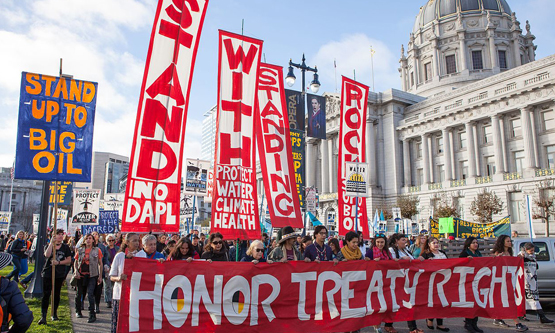
Standing Rock solidarity march in San Francisco, November 2016
FRFI is pleased to publish this guest article by Taryn Fivek from the Workers World Party in the US, where self-described water protectors – Native Americans and allied opponents of the planned Dakota Access Pipeline that threatens to poison water supplies and sacred native lands – have been staging a peaceful occupation since August to protect the indigenous reservation of Standing Rock in the state of North Dakota.
Since writing, despite growing international support for the protesters, police have stepped up repression by firing water cannon on protesters and their camps. Used in freezing temperatures, there are serious concerns that protesters could develop severe hypothermia as a result. Police have also fired flash bang grenades, rubber bullets, Long-Range Acoustic Devices and tear gas. Among many serious injuries, a 21-year-old woman from New York is likely to have what remains of her left arm amputated after being hit by a concussion grenade. The CEO of pipeline developer Energy Transfer Partners has reportedly offered to reimburse the state for law enforcement costs which have spiralled to $10.9m. You can follow Taryn on Twitter at @fivek.
Standing Rock, North Dakota, is a two-day drive from Denver, Colorado. Most of it is along poorly maintained country roads. The closest airport is in Bismarck, about an hour north by car. If there are people who want to travel to show solidarity with the water protectors in Standing Rock, they generally must travel for many days to reach North Dakota. There are people and other indigenous nations from all over the world represented here, with some even arriving by canoe. A Palestinian flag has joined the hundreds of others welcoming solidarity activists to the camp. The Dakotas look deceptively small on a map, but the area is vast and open. The wind whips sharply across the plains like a sail.
But now, nearing the edge of the winter months, temperatures are already dropping below freezing at night and even during the day. The makeshift camp of thousands of Native Americans and those who support them has no reliable cell phone service, making communication with the world an ongoing struggle. One of the highest points of the camp, where you can find cellphone service, has been dubbed ‘Facebook Hill’.
Despite the hardships, the resistance continues against the Dakota Access Pipeline, a $3.8 billion project to move oil from the Bakken fields in northwest North Dakota to refineries and other transport in Illinois. The pipeline passes across the Missouri River at Standing Rock Sioux Reservation, one of the largest in the United States at 9,251 sq km. An earlier proposal had the pipeline crossing north of nearby Bismark, but after concerns were raised by the white middle class about the possibility of contaminating the water supply, the plan was re-routed to cross at the northern part of Standing Rock.
As temperatures become more severe, so has the aggression against the water protectors, many of them youth and women of colour. Dispatches over social media sent daily from inside the struggle, many originating from what is known as Red Warrior Camp, show militarised police beating elders, trucks driving through the water protectors, guns fired, horses shot. Water protectors have been abducted by the police and kept in dog kennels.
To keep up the momentum and show people at Standing Rock that millions support them, a national day of solidarity was called on 15 November 2016, with actions held in 250 locations across 43 states. Activists are also sabotaging existing oil pipelines across the country by switching them off or setting fire to equipment.
The history of resistance to colonialism by Native Americans is as long as the history of the United States itself. The Lakota and Dakota Sioux, whose sovereignty the Dakota Access Pipeline is currently violating, suffer from occupation and settler violence. The Sioux men at nearby Pine Ridge have a life expectancy of 48, the lowest in the Western Hemisphere except for Haiti. Despite this, the Lakota and Dakota nations are home to freedom fighters such as Sitting Bull, Crazy Horse, Red Cloud, Young Man Afraid of His Horses, Russell Means and Leonard Peltier, political prisoner of 40 years.
Capitalism and white supremacy go hand-in-hand in the United States. The working class and oppressed here have been galvanised by Donald Trump’s recent selection as the new face of global capitalism. The people fighting at Standing Rock might be cold at night, but efforts at preparing for winter have been underway since September and they intend to stay as long as necessary to ensure that both the water and indigenous sovereignty is protected.
Fight Racism! Fight Imperialism! 254 December 2016/January 2017




